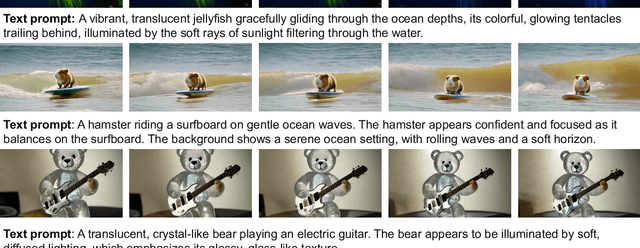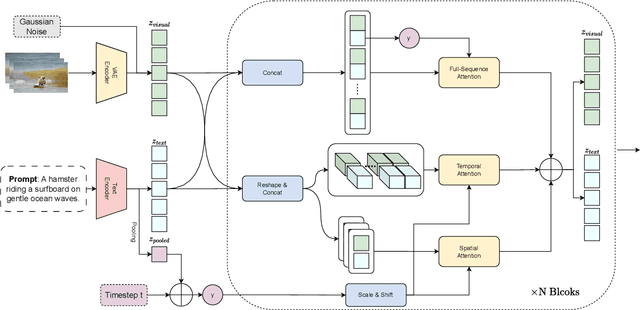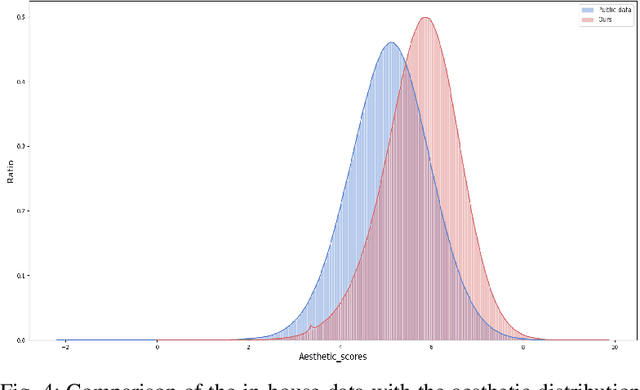Chenyang Si
V-STaR: Benchmarking Video-LLMs on Video Spatio-Temporal Reasoning
Mar 14, 2025Abstract:Human processes video reasoning in a sequential spatio-temporal reasoning logic, we first identify the relevant frames ("when") and then analyse the spatial relationships ("where") between key objects, and finally leverage these relationships to draw inferences ("what"). However, can Video Large Language Models (Video-LLMs) also "reason through a sequential spatio-temporal logic" in videos? Existing Video-LLM benchmarks primarily focus on assessing object presence, neglecting relational reasoning. Consequently, it is difficult to measure whether a model truly comprehends object interactions (actions/events) in videos or merely relies on pre-trained "memory" of co-occurrences as biases in generating answers. In this work, we introduce a Video Spatio-Temporal Reasoning (V-STaR) benchmark to address these shortcomings. The key idea is to decompose video understanding into a Reverse Spatio-Temporal Reasoning (RSTR) task that simultaneously evaluates what objects are present, when events occur, and where they are located while capturing the underlying Chain-of-thought (CoT) logic. To support this evaluation, we construct a dataset to elicit the spatial-temporal reasoning process of Video-LLMs. It contains coarse-to-fine CoT questions generated by a semi-automated GPT-4-powered pipeline, embedding explicit reasoning chains to mimic human cognition. Experiments from 14 Video-LLMs on our V-STaR reveal significant gaps between current Video-LLMs and the needs for robust and consistent spatio-temporal reasoning.
CoS: Chain-of-Shot Prompting for Long Video Understanding
Feb 10, 2025



Abstract:Multi-modal Large Language Models (MLLMs) struggle with long videos due to the need for excessive visual tokens. These tokens exceed massively the context length of MLLMs, resulting in filled by redundant task-irrelevant shots. How to select shots is an unsolved critical problem: sparse sampling risks missing key details, while exhaustive sampling overwhelms the model with irrelevant content, leading to video misunderstanding. To solve this problem, we propose Chain-of-Shot prompting (CoS). The key idea is to frame shot selection as test-time visual prompt optimisation, choosing shots adaptive to video understanding semantic task by optimising shots-task alignment. CoS has two key parts: (1) a binary video summary mechanism that performs pseudo temporal grounding, discovering a binary coding to identify task-relevant shots, and (2) a video co-reasoning module that deploys the binary coding to pair (learning to align) task-relevant positive shots with irrelevant negative shots. It embeds the optimised shot selections into the original video, facilitating a focus on relevant context to optimize long video understanding. Experiments across three baselines and five datasets demonstrate the effectiveness and adaptability of CoS. Code given in https://lwpyh.github.io/CoS.
Lumina-Video: Efficient and Flexible Video Generation with Multi-scale Next-DiT
Feb 10, 2025Abstract:Recent advancements have established Diffusion Transformers (DiTs) as a dominant framework in generative modeling. Building on this success, Lumina-Next achieves exceptional performance in the generation of photorealistic images with Next-DiT. However, its potential for video generation remains largely untapped, with significant challenges in modeling the spatiotemporal complexity inherent to video data. To address this, we introduce Lumina-Video, a framework that leverages the strengths of Next-DiT while introducing tailored solutions for video synthesis. Lumina-Video incorporates a Multi-scale Next-DiT architecture, which jointly learns multiple patchifications to enhance both efficiency and flexibility. By incorporating the motion score as an explicit condition, Lumina-Video also enables direct control of generated videos' dynamic degree. Combined with a progressive training scheme with increasingly higher resolution and FPS, and a multi-source training scheme with mixed natural and synthetic data, Lumina-Video achieves remarkable aesthetic quality and motion smoothness at high training and inference efficiency. We additionally propose Lumina-V2A, a video-to-audio model based on Next-DiT, to create synchronized sounds for generated videos. Codes are released at https://www.github.com/Alpha-VLLM/Lumina-Video.
RepVideo: Rethinking Cross-Layer Representation for Video Generation
Jan 15, 2025



Abstract:Video generation has achieved remarkable progress with the introduction of diffusion models, which have significantly improved the quality of generated videos. However, recent research has primarily focused on scaling up model training, while offering limited insights into the direct impact of representations on the video generation process. In this paper, we initially investigate the characteristics of features in intermediate layers, finding substantial variations in attention maps across different layers. These variations lead to unstable semantic representations and contribute to cumulative differences between features, which ultimately reduce the similarity between adjacent frames and negatively affect temporal coherence. To address this, we propose RepVideo, an enhanced representation framework for text-to-video diffusion models. By accumulating features from neighboring layers to form enriched representations, this approach captures more stable semantic information. These enhanced representations are then used as inputs to the attention mechanism, thereby improving semantic expressiveness while ensuring feature consistency across adjacent frames. Extensive experiments demonstrate that our RepVideo not only significantly enhances the ability to generate accurate spatial appearances, such as capturing complex spatial relationships between multiple objects, but also improves temporal consistency in video generation.
Vchitect-2.0: Parallel Transformer for Scaling Up Video Diffusion Models
Jan 14, 2025



Abstract:We present Vchitect-2.0, a parallel transformer architecture designed to scale up video diffusion models for large-scale text-to-video generation. The overall Vchitect-2.0 system has several key designs. (1) By introducing a novel Multimodal Diffusion Block, our approach achieves consistent alignment between text descriptions and generated video frames, while maintaining temporal coherence across sequences. (2) To overcome memory and computational bottlenecks, we propose a Memory-efficient Training framework that incorporates hybrid parallelism and other memory reduction techniques, enabling efficient training of long video sequences on distributed systems. (3) Additionally, our enhanced data processing pipeline ensures the creation of Vchitect T2V DataVerse, a high-quality million-scale training dataset through rigorous annotation and aesthetic evaluation. Extensive benchmarking demonstrates that Vchitect-2.0 outperforms existing methods in video quality, training efficiency, and scalability, serving as a suitable base for high-fidelity video generation.
Diffusion as Shader: 3D-aware Video Diffusion for Versatile Video Generation Control
Jan 07, 2025



Abstract:Diffusion models have demonstrated impressive performance in generating high-quality videos from text prompts or images. However, precise control over the video generation process, such as camera manipulation or content editing, remains a significant challenge. Existing methods for controlled video generation are typically limited to a single control type, lacking the flexibility to handle diverse control demands. In this paper, we introduce Diffusion as Shader (DaS), a novel approach that supports multiple video control tasks within a unified architecture. Our key insight is that achieving versatile video control necessitates leveraging 3D control signals, as videos are fundamentally 2D renderings of dynamic 3D content. Unlike prior methods limited to 2D control signals, DaS leverages 3D tracking videos as control inputs, making the video diffusion process inherently 3D-aware. This innovation allows DaS to achieve a wide range of video controls by simply manipulating the 3D tracking videos. A further advantage of using 3D tracking videos is their ability to effectively link frames, significantly enhancing the temporal consistency of the generated videos. With just 3 days of fine-tuning on 8 H800 GPUs using less than 10k videos, DaS demonstrates strong control capabilities across diverse tasks, including mesh-to-video generation, camera control, motion transfer, and object manipulation.
VBench++: Comprehensive and Versatile Benchmark Suite for Video Generative Models
Nov 20, 2024



Abstract:Video generation has witnessed significant advancements, yet evaluating these models remains a challenge. A comprehensive evaluation benchmark for video generation is indispensable for two reasons: 1) Existing metrics do not fully align with human perceptions; 2) An ideal evaluation system should provide insights to inform future developments of video generation. To this end, we present VBench, a comprehensive benchmark suite that dissects "video generation quality" into specific, hierarchical, and disentangled dimensions, each with tailored prompts and evaluation methods. VBench has several appealing properties: 1) Comprehensive Dimensions: VBench comprises 16 dimensions in video generation (e.g., subject identity inconsistency, motion smoothness, temporal flickering, and spatial relationship, etc). The evaluation metrics with fine-grained levels reveal individual models' strengths and weaknesses. 2) Human Alignment: We also provide a dataset of human preference annotations to validate our benchmarks' alignment with human perception, for each evaluation dimension respectively. 3) Valuable Insights: We look into current models' ability across various evaluation dimensions, and various content types. We also investigate the gaps between video and image generation models. 4) Versatile Benchmarking: VBench++ supports evaluating text-to-video and image-to-video. We introduce a high-quality Image Suite with an adaptive aspect ratio to enable fair evaluations across different image-to-video generation settings. Beyond assessing technical quality, VBench++ evaluates the trustworthiness of video generative models, providing a more holistic view of model performance. 5) Full Open-Sourcing: We fully open-source VBench++ and continually add new video generation models to our leaderboard to drive forward the field of video generation.
FasterCache: Training-Free Video Diffusion Model Acceleration with High Quality
Oct 25, 2024



Abstract:In this paper, we present \textbf{\textit{FasterCache}}, a novel training-free strategy designed to accelerate the inference of video diffusion models with high-quality generation. By analyzing existing cache-based methods, we observe that \textit{directly reusing adjacent-step features degrades video quality due to the loss of subtle variations}. We further perform a pioneering investigation of the acceleration potential of classifier-free guidance (CFG) and reveal significant redundancy between conditional and unconditional features within the same timestep. Capitalizing on these observations, we introduce FasterCache to substantially accelerate diffusion-based video generation. Our key contributions include a dynamic feature reuse strategy that preserves both feature distinction and temporal continuity, and CFG-Cache which optimizes the reuse of conditional and unconditional outputs to further enhance inference speed without compromising video quality. We empirically evaluate FasterCache on recent video diffusion models. Experimental results show that FasterCache can significantly accelerate video generation (\eg 1.67$\times$ speedup on Vchitect-2.0) while keeping video quality comparable to the baseline, and consistently outperform existing methods in both inference speed and video quality.
HPFF: Hierarchical Locally Supervised Learning with Patch Feature Fusion
Jul 09, 2024Abstract:Traditional deep learning relies on end-to-end backpropagation for training, but it suffers from drawbacks such as high memory consumption and not aligning with biological neural networks. Recent advancements have introduced locally supervised learning, which divides networks into modules with isolated gradients and trains them locally. However, this approach can lead to performance lag due to limited interaction between these modules, and the design of auxiliary networks occupies a certain amount of GPU memory. To overcome these limitations, we propose a novel model called HPFF that performs hierarchical locally supervised learning and patch-level feature computation on the auxiliary networks. Hierarchical Locally Supervised Learning (HiLo) enables the network to learn features at different granularity levels along their respective local paths. Specifically, the network is divided into two-level local modules: independent local modules and cascade local modules. The cascade local modules combine two adjacent independent local modules, incorporating both updates within the modules themselves and information exchange between adjacent modules. Patch Feature Fusion (PFF) reduces GPU memory usage by splitting the input features of the auxiliary networks into patches for computation. By averaging these patch-level features, it enhances the network's ability to focus more on those patterns that are prevalent across multiple patches. Furthermore, our method exhibits strong generalization capabilities and can be seamlessly integrated with existing techniques. We conduct experiments on CIFAR-10, STL-10, SVHN, and ImageNet datasets, and the results demonstrate that our proposed HPFF significantly outperforms previous approaches, consistently achieving state-of-the-art performance across different datasets. Our code is available at: https://github.com/Zeudfish/HPFF.
Momentum Auxiliary Network for Supervised Local Learning
Jul 09, 2024



Abstract:Deep neural networks conventionally employ end-to-end backpropagation for their training process, which lacks biological credibility and triggers a locking dilemma during network parameter updates, leading to significant GPU memory use. Supervised local learning, which segments the network into multiple local blocks updated by independent auxiliary networks. However, these methods cannot replace end-to-end training due to lower accuracy, as gradients only propagate within their local block, creating a lack of information exchange between blocks. To address this issue and establish information transfer across blocks, we propose a Momentum Auxiliary Network (MAN) that establishes a dynamic interaction mechanism. The MAN leverages an exponential moving average (EMA) of the parameters from adjacent local blocks to enhance information flow. This auxiliary network, updated through EMA, helps bridge the informational gap between blocks. Nevertheless, we observe that directly applying EMA parameters has certain limitations due to feature discrepancies among local blocks. To overcome this, we introduce learnable biases, further boosting performance. We have validated our method on four image classification datasets (CIFAR-10, STL-10, SVHN, ImageNet), attaining superior performance and substantial memory savings. Notably, our method can reduce GPU memory usage by more than 45\% on the ImageNet dataset compared to end-to-end training, while achieving higher performance. The Momentum Auxiliary Network thus offers a new perspective for supervised local learning. Our code is available at: https://github.com/JunhaoSu0/MAN.
 Add to Chrome
Add to Chrome Add to Firefox
Add to Firefox Add to Edge
Add to Edge